News
The outdoor pavilion in the center of Mimpi Resort Menjangan rang with shouts of “Potatoes! Very Cheap!” “$6 a bag! Who will sell for 6?” “Cheapest in town! Come see my potatoes!” “Who wants to make a deal?” And our course on Economic Tools for Marine Conservation in Indonesia was underway. Twenty-two participants from institutions around the country were engaged in their first economic game, experiencing the principles of microeconomics by participating in a market, and working towards an equilibrium price for a sack of potatoes.
Tapajós river basin, Pará State, Brazil © Camila Jericó-Daminello
After an inventory of potential dams in the Tapajós river basin was released in 2008, the area has been hailed as the new frontier of energy development in Brazil. Due to the typically extensive environmental and social impacts of dam construction, governments and communities in the Amazon region have been engaged in discussions over the past few years on how to mitigate impacts on people and nature. Some dam projects are already underway with many more on the drawing board.
Amazonas native. © Fernanda Preto
CSF International Course graduate Prakash Mani Sharma, Executive Director and Senior Advocate for Pro Public, wrote to us last month with some stunning news. On April 16th, 2015, the Supreme Court of Nepal set a precedent in the area of environment protection by ordering the closure of the mining company, Godawari Marble Industries. This decision is the result of over a decade of litigation by Pro Public to protect the 330 species of butterflies, 254 birds, 80 tree varieties, and 571 types of fruits in Godawari and the Phulchowki hills near the mine.
Photo credit: Fernanda Preto
There’s no Wikipedia page so you can be forgiven for suspecting that I’m making it up. But Conservation Economics is actually being practiced by a bunch of serious people engaged in one of the most profound challenges of our time - averting massive losses in the diversity of Earth's life forms. So if it doesn’t exist, it’s time we brought it into being. Here goes:
Workers collecting palm oil fruit
In a world of vast natural ecosystems, endlessly diverse life forms and similarly numerous threats to nature, how can people make smart choices about what to try to conserve? It takes biological expertise, to be sure, but economics is also a necessary compass to guide our efforts.
Mountain Gorillas in Virunga National Park, Photo ©2023 Virunga National Park
Por: Claudia Ochoa, colaboradora
La tercera semana de enero visitamos la Amazonía peruana para avanzar con los preparativos del curso Herramientas Económicas para la Conservación en la Amazonía Andina: Manejo de Recursos Naturales y Sostenibilidad Financiera en Áreas Protegidas que se llevará a cabo en la ciudad de Iquitos entre el 9 y 20 de marzo del presente año.
Fern-choked hillside on a lovely stretch of the Camino de Santiago. © John Reid
I spent five days in December walking through Spain's Basque Country on the northern variant of the ancient pilgrimage route to Santiago de Compostela. And also walking through the Anthropocene, a geologic era recently declared by non-geologists to describe our time, an epoch in which people shape the earth more than plate tectonics or asteroid collisions.


